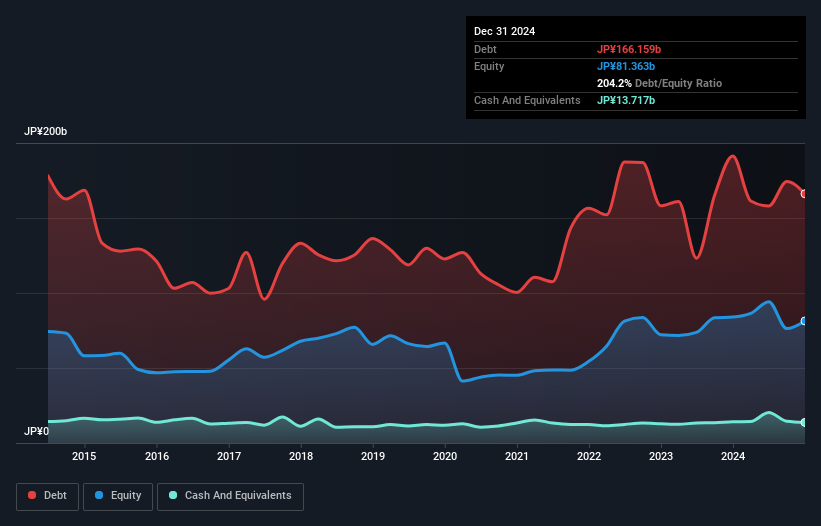- Japan
- /
- Oil and Gas
- /
- TSE:5017
These 4 Measures Indicate That Fuji Oil Company (TSE:5017) Is Using Debt In A Risky Way

The external fund manager backed by Berkshire Hathaway's Charlie Munger, Li Lu, makes no bones about it when he says 'The biggest investment risk is not the volatility of prices, but whether you will suffer a permanent loss of capital.' When we think about how risky a company is, we always like to look at its use of debt, since debt overload can lead to ruin. Importantly, Fuji Oil Company, Ltd. (TSE:5017) does carry debt. But the more important question is: how much risk is that debt creating?
Why Does Debt Bring Risk?
Debt is a tool to help businesses grow, but if a business is incapable of paying off its lenders, then it exists at their mercy. In the worst case scenario, a company can go bankrupt if it cannot pay its creditors. However, a more usual (but still expensive) situation is where a company must dilute shareholders at a cheap share price simply to get debt under control. Of course, plenty of companies use debt to fund growth, without any negative consequences. When we examine debt levels, we first consider both cash and debt levels, together.
How Much Debt Does Fuji Oil Company Carry?
As you can see below, Fuji Oil Company had JP¥166.2b of debt at December 2024, down from JP¥191.4b a year prior. On the flip side, it has JP¥13.7b in cash leading to net debt of about JP¥152.4b.

How Healthy Is Fuji Oil Company's Balance Sheet?
The latest balance sheet data shows that Fuji Oil Company had liabilities of JP¥267.1b due within a year, and liabilities of JP¥38.9b falling due after that. Offsetting these obligations, it had cash of JP¥13.7b as well as receivables valued at JP¥101.6b due within 12 months. So its liabilities total JP¥190.7b more than the combination of its cash and short-term receivables.
This deficit casts a shadow over the JP¥22.6b company, like a colossus towering over mere mortals. So we'd watch its balance sheet closely, without a doubt. After all, Fuji Oil Company would likely require a major re-capitalisation if it had to pay its creditors today.
See our latest analysis for Fuji Oil Company
We use two main ratios to inform us about debt levels relative to earnings. The first is net debt divided by earnings before interest, tax, depreciation, and amortization (EBITDA), while the second is how many times its earnings before interest and tax (EBIT) covers its interest expense (or its interest cover, for short). Thus we consider debt relative to earnings both with and without depreciation and amortization expenses.
Weak interest cover of 2.0 times and a disturbingly high net debt to EBITDA ratio of 13.8 hit our confidence in Fuji Oil Company like a one-two punch to the gut. This means we'd consider it to have a heavy debt load. Worse, Fuji Oil Company's EBIT was down 68% over the last year. If earnings continue to follow that trajectory, paying off that debt load will be harder than convincing us to run a marathon in the rain. When analysing debt levels, the balance sheet is the obvious place to start. But ultimately the future profitability of the business will decide if Fuji Oil Company can strengthen its balance sheet over time. So if you want to see what the professionals think, you might find this free report on analyst profit forecasts to be interesting.
But our final consideration is also important, because a company cannot pay debt with paper profits; it needs cold hard cash. So we clearly need to look at whether that EBIT is leading to corresponding free cash flow. During the last three years, Fuji Oil Company burned a lot of cash. While that may be a result of expenditure for growth, it does make the debt far more risky.
Our View
To be frank both Fuji Oil Company's EBIT growth rate and its track record of staying on top of its total liabilities make us rather uncomfortable with its debt levels. And even its net debt to EBITDA fails to inspire much confidence. It looks to us like Fuji Oil Company carries a significant balance sheet burden. If you play with fire you risk getting burnt, so we'd probably give this stock a wide berth. When analysing debt levels, the balance sheet is the obvious place to start. But ultimately, every company can contain risks that exist outside of the balance sheet. Be aware that Fuji Oil Company is showing 4 warning signs in our investment analysis , and 2 of those can't be ignored...
When all is said and done, sometimes its easier to focus on companies that don't even need debt. Readers can access a list of growth stocks with zero net debt 100% free, right now.
New: AI Stock Screener & Alerts
Our new AI Stock Screener scans the market every day to uncover opportunities.
• Dividend Powerhouses (3%+ Yield)
• Undervalued Small Caps with Insider Buying
• High growth Tech and AI Companies
Or build your own from over 50 metrics.
Have feedback on this article? Concerned about the content? Get in touch with us directly. Alternatively, email editorial-team (at) simplywallst.com.
This article by Simply Wall St is general in nature. We provide commentary based on historical data and analyst forecasts only using an unbiased methodology and our articles are not intended to be financial advice. It does not constitute a recommendation to buy or sell any stock, and does not take account of your objectives, or your financial situation. We aim to bring you long-term focused analysis driven by fundamental data. Note that our analysis may not factor in the latest price-sensitive company announcements or qualitative material. Simply Wall St has no position in any stocks mentioned.
About TSE:5017
Fuji Oil Company
Engages in refining, producing, processing, storing, and selling petroleum products and petrochemical feedstock.
Slight with moderate growth potential.
Similar Companies
Market Insights
Community Narratives





